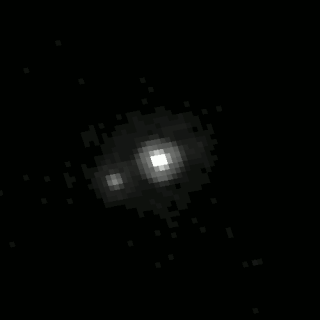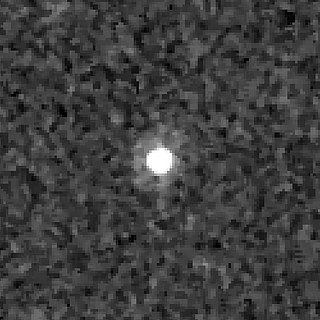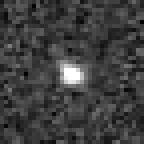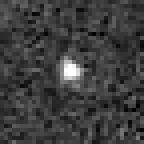Related Research Articles

Orcus is a dwarf planet located in the Kuiper belt, with one large moon, Vanth. It has an estimated diameter of 870 to 960 km, comparable to the Inner Solar System dwarf planet Ceres. The surface of Orcus is relatively bright with albedo reaching 23 percent, neutral in color, and rich in water ice. The ice is predominantly in crystalline form, which may be related to past cryovolcanic activity. Other compounds like methane or ammonia may also be present on its surface. Orcus was discovered by American astronomers Michael Brown, Chad Trujillo, and David Rabinowitz on 17 February 2004.
8405 Asbolus is a centaur orbiting in the outer Solar System between the orbits of Jupiter and Neptune. It was discovered on 5 April 1995, by James Scotti and Robert Jedicke of Spacewatch (credited) at Kitt Peak Observatory in Arizona, United States. It is named after Asbolus, a centaur in Greek mythology and measures approximately 80 kilometers in diameter.

(19308) 1996 TO66 (provisional designation 1996 TO66) is a trans-Neptunian object that was discovered in 1996 by Chadwick Trujillo, David Jewitt and Jane Luu. Until 20000 Varuna was discovered, it was the second-largest known object in the Kuiper belt, after Pluto.

38628 Huya ( hoo-YAH; provisional designation 2000 EB173) is a binary trans-Neptunian object located in the Kuiper belt, a region of icy objects orbiting beyond Neptune in the outer Solar System. Huya is classified as a plutino, a dynamical class of trans-Neptunian objects with orbits in a 3:2 orbital resonance with Neptune. It was discovered by the Quasar Equatorial Survey Team and was identified by Venezuelan astronomer Ignacio Ferrín in March 2000. It is named after Juyá, the mythological rain god of the Wayuu people native to South America.
(84719) 2002 VR128 (provisional designation 2002 VR128) is a trans-Neptunian object (TNO). It was discovered in 2002 by Michael Brown and Chad Trujillo. The object is a plutino, an object in 2:3 orbital resonance with Neptune.

(55565) 2002 AW197 (provisional designation 2002 AW197) is a classical, non-resonant trans-Neptunian object from the Kuiper belt in the outermost region of the Solar System, also known as a cubewano. It is the tenth-intrinsically-brightest known trans-Neptunian objct, and with a likely diameter of at least 600 kilometers (400 miles), it is approximately tied with 2002 MS4 and 2013 FY27 (to within measurement uncertainties) as the largest unnamed object in the Solar System. It was discovered at Palomar Observatory in 2002.

(84522) 2002 TC302 (provisional designation 2002 TC302) is a mid-sized trans-Neptunian object located in the outermost region of the Solar System. It was discovered on 9 October 2002, by American astronomers Mike Brown, Chad Trujillo and David Rabinowitz at the Palomar Observatory in California. The resonant trans-Neptunian object stays in a 2:5 resonance with Neptune. It has a reddish color, a rotation period of 56.1 hours and measures at least 500 kilometers (310 miles) in diameter.

7066 Nessus is a very red centaur on an eccentric orbit, located beyond Saturn in the outer Solar System. It was discovered on 26 April 1993, by astronomers of the Spacewatch program at the Kitt Peak National Observatory in Tucson, Arizona. The dark and reddish minor planet is likely elongated and measures approximately 60 kilometers in diameter. It was named after Nessus from Greek mythology.

10370 Hylonome (; prov. designation: 1995 DW2) is a minor planet orbiting in the outer Solar System. The dark and icy body belongs to the class of centaurs and measures approximately 72 kilometers (45 miles) in diameter. It was discovered on 27 February 1995, by English astronomer David C. Jewitt and Vietnamese American astronomer Jane Luu at the U.S. Mauna Kea Observatory in Hawaii, and later named after the mythological creature Hylonome.

(208996) 2003 AZ84 (provisional designation 2003 AZ84) is a trans-Neptunian object with a possible moon located in the outer regions of the Solar System. It is approximately 940 kilometers across its longest axis, as it has an elongated shape. It belongs to the plutinos – a group of minor planets named after its largest member Pluto – as it orbits in a 2:3 resonance with Neptune in the Kuiper belt. It is the third-largest known plutino, after Pluto and Orcus. It was discovered on 13 January 2003, by American astronomers Chad Trujillo and Michael Brown during the NEAT survey using the Samuel Oschin telescope at Palomar Observatory.

(84922) 2003 VS2 is a trans-Neptunian object discovered by the Near Earth Asteroid Tracking program on 14 November 2003. Like Pluto, it is in a 2:3 orbital resonance with Neptune and is thus a plutino. Analysis of light-curve suggests that it is not a dwarf planet.

(15875) 1996 TP66 (provisional designation 1996 TP66) is a resonant trans-Neptunian object of the plutino population, located in the outermost region of the Solar System, approximately 154 kilometers (96 miles) in diameter. It was discovered on 11 October 1996, by astronomers Jane Luu, David C. Jewitt and Chad Trujillo at the Mauna Kea Observatories, Hawaii, in the United States. The very reddish RR-type with a highly eccentric orbit has been near its perihelion around the time of its discovery. This minor planet was numbered in 2000 and has since not been named. It is probably not a dwarf planet candidate.

(469372) 2001 QF298, provisionally known as 2001 QF298, is a resonant trans-Neptunian object that resides in the Kuiper belt in the outermost region of the Solar System. It was discovered on August 19, 2001 by Marc W. Buie. 2001 QF298 is a plutino, meaning that it is locked in a 3:2 orbital resonance with Neptune, much like Pluto.
(35671) 1998 SN165 (provisional designation 1998 SN165) is a trans-Neptunian object from the Kuiper belt located in the outermost region of the Solar System. It was discovered on 23 September 1998, by American astronomer Arianna Gleason at the Kitt Peak National Observatory near Tucson, Arizona. The cold classical Kuiper belt object is a dwarf planet candidate, as it measures approximately 400 kilometers (250 miles) in diameter. It has a grey-blue color (BB) and a rotation period of 8.8 hours. As of 2021, it has not been named.

(612533) 2002 XV93 (provisional designation 2002 XV93) is a trans-Neptunian object (TNO) with an absolute magnitude of 5.4. A 2:3 orbital resonance with Neptune makes it a plutino.
(144897) 2004 UX10 (provisional designation 2004 UX10) is a Kuiper-belt object. It has a diameter of about 360 kilometres (220 mi) and was discovered by Andrew Becker, Andrew Puckett and Jeremy Kubica on 20 October 2004 at Apache Point Observatory in Sunspot, New Mexico. The object is classified as a cubewano. It is near a 2:3 resonance with Neptune.
(469306) 1999 CD158 (provisional designation 1999 CD158) is a resonant trans-Neptunian object from the circumstellar disc of the Kuiper belt, located in the outermost region of the Solar System. It measures approximately 310 kilometers (190 miles) in diameter. It was discovered on 10 February 1999, by American astronomers Jane Luu, David Jewitt, and Chad Trujillo at Mauna Kea Observatories on the Big Island of Hawaii, United States.
(148975) 2001 XA255, provisional designation: 2001 XA255, is a dark minor planet in the outer Solar System, classified as centaur, approximately 38 kilometers (24 miles) in diameter. It was discovered on 9 December 2001, by David C. Jewitt, Scott S. Sheppard, and Jan Kleyna observing from the Mauna Kea Observatory. The object is currently trapped in a 1:1 mean-motion resonance with Neptune following a path of the horseshoe type.
(310071) 2010 KR59, provisional designation 2010 KR59, is a trans-Neptunian object, approximately 110 kilometers in diameter. The object is trapped in a 1:1 mean motion resonance with Neptune, and rotates nearly every 9 hours around its axis. It was discovered on May 18, 2010 at 7:45 UT by the WISE spacecraft. The WISE telescope scanned the entire sky in infrared light from January 2010 to February 2011.

(82158) 2001 FP185 (provisional designation 2001 FP185) is a highly eccentric trans-Neptunian object from the scattered disc in the outermost part of the Solar System, approximately 330 kilometers in diameter. It was discovered on 26 March 2001, by American astronomer Marc Buie at Kitt Peak National Observatory in Arizona, United States.
References
- 1 2 "List Of Transneptunian Objects". IAU Minor Planet Center . Retrieved 2011-01-08.
- ↑ "MPEC 2009-R09 :Distant Minor Planets (16 September 2009.0 TT)". IAU Minor Planet Center. 2009-09-04. Retrieved 2009-10-04.
- 1 2 "JPL Small-Body Database Browser: (126154) 2001 YH140" (last obs). 2009-02-02. Retrieved 11 April 2016.
- 1 2 3 4 5 6 Müller, T. G.; Lellouch, E.; Stansberry, J.; Kiss, C.; Santos-Sanz, P.; Vilenius, E.; Protopapa, S.; Moreno, R.; Mueller, M.; Delsanti, A.; Duffard, R.; Fornasier, S.; Groussin, O.; Harris, A. W.; Henry, F.; Horner, J.; Lacerda, P.; Lim, T.; Mommert, M.; Ortiz, J. L.; Rengel, M.; Thirouin, A.; Trilling, D.; Barucci, A.; Crovisier, J.; Doressoundiram, A.; Dotto, E.; Gutiérrez, P. J.; Hainaut, O. R.; Hartogh, P. (July–August 2010). ""TNOs are Cool": A survey of the trans-Neptunian region". Astronomy and Astrophysics . 518: L146. arXiv: 1005.2923 . Bibcode:2010A&A...518L.146M. doi:10.1051/0004-6361/201014683. S2CID 118635387.
- 1 2 Sheppard, Scott S. (August 2007). "Light Curves of Dwarf Plutonian Planets and other Large Kuiper Belt Objects: Their Rotations, Phase Functions, and Absolute Magnitudes". The Astronomical Journal . 134 (2): 787–798. arXiv: 0704.1636 . Bibcode:2007AJ....134..787S. doi:10.1086/519072. S2CID 56247384.